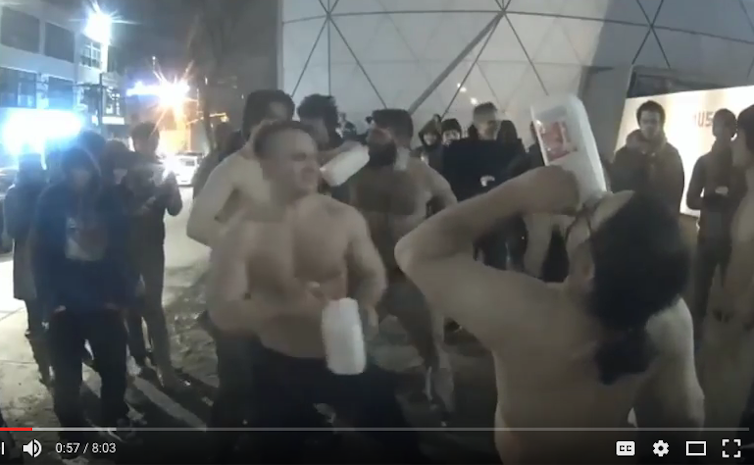The U.S.-based white supremacist movement that calls itself the “alt-right” has recently embraced milk as a symbol. In February, shirtless neo-Nazi protesters danced outside Shia LaBeouf’s anti-Trump art installation, He Will Not Divide Us, chugging gallons of milk that dripped messily down their chins.
Later, they claimed this act symbolized their opposition to “the vegan agenda.”
A poem appeared on an extreme right-wing news site, insisting: “roses are red, barack (sic) is half black, if you can’t drink milk, you have to go back.”
Other white supremacist discussion threads feature a map of the world tracking lactose intolerance, and academic studies of lactose intolerance in a Slavic population.

New emoji, old symbol
Milk as a symbol of white supremacy has also entered the Twitterverse. In early 2017, it replaced Pepe the Frog as the newest emoji symbolizing white superiority.
Infamous white supremacists Richard Spencer, president of the white nationalist think tank, National Policy Institute, and Tim Treadstone, the extreme right wing social media personality who goes by the name of Baked Alaska, both added milk symbols to their Twitter profiles.
In the box office hit Get Out, a white slave trader slowly sips on a glass of milk in a quiet moment.
I am a critical race scholar and law professor at the University of Hawaii Richardson School of Law. In my law review article, The Unbearable Whiteness of Milk, I discuss the association between milk and white superiority.
It’s not a new relationship. Instead, it dates back approximately 100 years. In the 1920s, a pamphlet from the U.S. National Dairy Council explained: “The people who have used liberal amounts of milk and its products … ” — meaning white people — “… are progressive in science and every activity of the human intellect.”
Similarly, the 1933 History of Agriculture of the State of New York declared: “A casual look at the races of people seems to show that those using much milk are the strongest physically and mentally, and the most enduring of the people of the world. Of all races, the Aryans seem to have been the heaviest drinkers of milk and the greatest users of butter and cheese, a fact that may in part account for the quick and high development of this division of human beings.”
There is, in fact, a biological basis for Richard Spencer’s Twitter boast that he is “very tolerant…lactose-tolerant!”
While most of the world cannot comfortably digest milk, a portion of the white population, originating from cold Scandinavian countries where drinking other species’ milk was a survival tool, can digest it with ease.
However, lactose-intolerance is not the worst of milk’s harms. Research links milk consumption to a host of serious health problems, including cancer and heart disease. There are significant [racial disparities in these milk-related illnesses, with groups including [African-Americans, Latinos], Native Americans and Native Hawaiians suffering the worst effects.

U.S. dietary guidelines may be racist
Nonetheless, the U.S. Farm Bill continues to subsidize the dairy industry, resulting in a surplus of milk. In turn, the Departments of Health and Human Services and Agriculture urge individuals to consume daily portions of milk products in the federal Dietary Guidelines .
The USDA also disposes of the surplus through its nutrition programs. It distributes milk in the form of free formula to mothers in the WIC (assistance to women and children) program and to public school students who qualify for free lunches. In both these programs, people of colour are disproportionately represented.
The USDA has also partnered with fast-food companies to create products with higher amounts of cheese, such as Domino’s American legends seven-cheese pizza line and Taco Bell’s quesalupa. The USDA conceived of and promoted these products, launching them through expensive and coveted Super Bowl advertising spots.
Although white people eat more fast food overall, people living in poor urban communities of colour disproportionately consume fast food in their diets. The decision to introduce more milk into fast-food products therefore has a disparate impact on the health of communities of colour. These communities are far removed from federal food policy-making, with little to no access to the political process, which is subject to regulatory capture.
Widespread belief in personal responsibility for health compounds the problem by making regulatory reform appear irrelevant or futile. The “healthism” paradigm insists that health is a matter of good character, not structural determinants.
Popular racial stereotypes cast African-Americans and Latinos as fat and lazy, lacking the will power necessary to ward off obesity and other food-related illnesses.
These cultural myths mask the systemic inequalities that lead to racial health disparities, and the fact that regulation could alter them. Both the government and the dairy industry thus stand to gain from these racial tropes.
At this moment in history, both white supremacists and federal food policy in the United States are engaging in oppression through milk.

